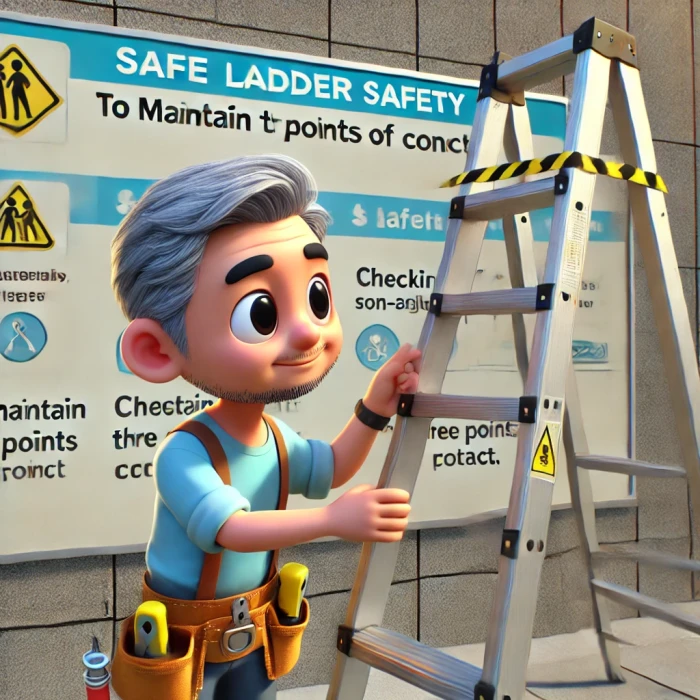Ladder safety is critical to prevent falls and injuries, especially when working in construction, maintenance, or any task involving elevated work. Here’s a comprehensive guide to ladder safety practices:
1. Choose the Right Ladder for the Job
- Select Ladder Type and Height: Use a ladder that suits the task, whether it’s a step ladder, extension ladder, or platform ladder, and ensure it’s tall enough to reach safely without standing on the top rung.
- Check Ladder Rating: Ensure the ladder is rated for the weight it needs to support, including the worker, tools, and materials. Look for load ratings (e.g., Type I for heavy-duty, Type II for medium-duty).
- Consider Material: Use non-conductive ladders (e.g., fiberglass) for electrical work to avoid electrocution.
2. Inspect the Ladder Before Use
- Check for Damage: Inspect the ladder for cracks, bent rungs, loose bolts, or any signs of wear and tear. Do not use damaged ladders.
- Inspect Rungs and Steps: Ensure that all rungs are clean, dry, and not slippery. Any dirt or grease should be wiped off.
- Examine Stability Features: Check that locks, braces, and feet are intact and functional. Make sure locks on extension ladders are fully engaged.
3. Set Up the Ladder Safely
- Position on Stable Ground: Set the ladder on a flat, stable surface, and avoid soft or uneven ground to prevent tilting.
- Maintain the 4:1 Angle: Place the ladder at a safe angle; for every 4 feet of ladder height, the base should be 1 foot out from the wall or structure.
- Secure the Ladder: Anchor or tie off the ladder when possible, especially if using an extension ladder or working on slippery surfaces.
4. Climb and Descend Safely
- Face the Ladder: Always face the ladder when climbing or descending, using both hands for stability.
- Three-Point Contact Rule: Maintain three points of contact (two hands and one foot, or two feet and one hand) at all times.
- Avoid Carrying Heavy Items: Use tool belts or hoist items separately to keep hands free for climbing.
5. Observe Weight Limits and Avoid Overloading
- One Person Per Ladder: Only one person should be on the ladder at a time unless the ladder is specifically designed for multiple users.
- Limit Tools and Materials: Avoid overloading the ladder with tools or materials, which could shift weight and make it unstable.
- Check for Body Positioning: Keep your belt buckle within the ladder’s side rails to avoid tipping or losing balance.
6. Maintain Proper Working Position
- Stay Centered: Avoid leaning or reaching too far to the side; if you need to reach an area, climb down and reposition the ladder.
- Don’t Stand on the Top Rung: Unless the ladder is specifically designed for it, avoid standing on the top two rungs to maintain balance.
- Use a Ladder Hook or Shelf for Tools: Use ladders with built-in shelves or hooks to secure tools and materials, preventing falls or accidental drops.
7. Avoid Hazardous Conditions
- Monitor Weather Conditions: Avoid ladder use in windy, rainy, or icy conditions, especially for outdoor tasks or when using metal ladders.
- Keep Ladders Clear of Doors and Windows: If setting up near doors or windows, ensure they are locked to prevent sudden opening.
- Work in Well-Lit Areas: Ensure adequate lighting, especially when working indoors or at night, to avoid visibility issues.
8. Train Workers and Promote Ladder Safety Awareness
- Provide Ladder Safety Training: Train employees on ladder setup, safe climbing techniques, and hazard awareness.
- Review Ladder Usage Policies: Regularly review ladder safety rules and make adjustments as needed to align with industry standards.
- Encourage Hazard Reporting: Workers should report any ladder defects or unsafe conditions immediately for repair or replacement.
9. Prepare for Emergencies
- Establish a Fall Response Plan: Have a protocol for responding to falls or ladder-related injuries, including first-aid readiness.
- Ensure Communication Access: Workers should have access to communication devices or an emergency contact system when working alone or at height.
10. Compliance and Regular Ladder Inspections
- Adhere to OSHA Standards: Follow OSHA or other local regulatory guidelines on ladder use, maintenance, and inspections.
- Conduct Routine Inspections: Check all ladders regularly for wear and damage, ensuring that only safe, functional ladders are in use.
- Document Ladder Conditions: Keep a record of inspections, repairs, and any incidents to monitor ladder safety over time.
By following these ladder safety guidelines, workplaces can significantly reduce fall hazards and protect workers from injury.


